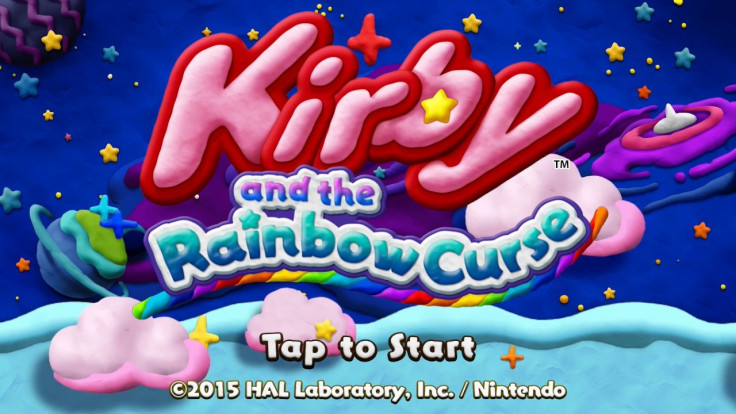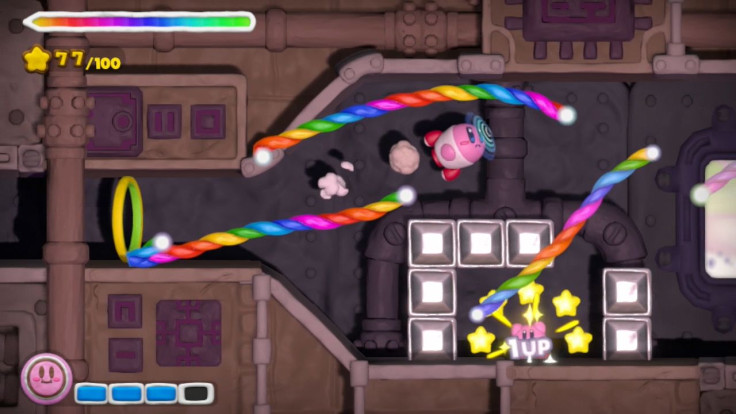Kirby And The Rainbow Curse Review: A New Experience For Veterans Of The Franchise [VIDEO]

Kirby the affable pink fluff is one of Nintendo's heavy hitters, sharing space and fame with the Mario and Legend of Zelda franchises. Unlike those two however, Nintendo often uses Kirby to experiment and take risks (something the company is generally not known to do). Usually it's things like art design and puzzle difficulty, but the first entry on the WiiU, Kirby and the Rainbow Curse, is not just a fancy animation style and HD graphics. It's so different that it actually doesn't feel like a Kirby game.
Traditional controls don’t exist here; you can only control Kirby with the Gamepad and stylus. The game is short, with only 28 stages across seven worlds (but it has a $40 price tag instead of the normal $60). And Kirby has been stripped of his most Kirby-esque ability: swallowing enemies to absorb their powers. With all this in mind, Kirby and the Rainbow Curse's existance is certainly strange. It's an interesting experiment, but it's not the game I hoped it would be.
The Good
There is some good to be said about it, however. There’s a serious lack of WiiU games that make a legitimate case for the Gamepad, but Rainbow Curse certainly tries (more on the downside of this later). Kirby rolls around like a squishy pinball, and can only progress through levels by riding on ropes, which you draw with the stylus. This completely changes the way you have to approach the game; normally Kirby is a fairly straightforward run and jump style platformer, but Rainbow Curse has a slower, more methodical approach.

The slow pace lets you appreciate all of the beautiful artwork. Claymation isn’t an art style I particularly like (I'm a big fan of the style in Kirby's Epic Yarn,and its upcoming spritual successor, Yoshi's Wooly World), but it’s a clever aesthetic for Kirby, since his character is all about flexibility and shapeshifting. There are three clay transformations in the game: a tank, a submarine, and a rocket, with levels smartly designed around their abilities. You don’t get to spend that much time with them (a few proprietary stages) but their levels are some of the most fun in the game..
Rainbow Curse isn’t a full-price game, so it is a bit short -- around 5-6 hours straight through. But there’s still a good number of unlockables, from figurines to classic music tracks, and its multiplayer is a nice addition.
It’s a charming, easy game. But for most, it's going to be a lackluster experience.
The Bad

As I've said before, Kirby is all about experimentation. But Nintendo decided to take his character in a direction I hope they never try again. His most iconic power -- sucking up enemies and absorbing their powers -- is absent. There's an argument to be made that this is where the Amiibos (Nintendo's line of figurines that store character data for games) come in -- you can tap a Kirby, MetaKnight, or King DeDeDe Amiibo on the WiiU Gamepad once per day to power up Kirby (nevermind that Amiibos cost extra money). A Kirby Amiibo lets you star dash (a charged rolling attack) without having to collect 100 stars first; MetaKnight grants Kirby a faster, more powerful normal dash; King DeDeDe gives Kirby two extra health bars. This is all well and good, until you lose a life.
If you die while powered up, the power goes away and can’t be used again for another 24 hours. These are effectively timers, a tactic many free-to-play mobile games implement to goad players into spending real money. There's a certain logic to them in a free-to-play mobile setting, but this is a AAA Nintendo franchise; timers are not welcome in retail releases. This setup begs a question: If Kirby’s not taking the powers of his enemies, is he really Kirby?
Iconic music aside, without control over Kirby's transformations this could have been a random new IP. It certainly would have made the new control scheme more understandable.

Kirby games are well-loved for tight, precise controls, but Kirby moves with all the precision of a sleepy toddler in Rainbow Curse. As mentioned before, the only way to control Kirby (I'm using "control" in a loose sense of the word) is to guide him along the braided ropes you draw. You can poke the pink ball to get him going, but from there everything is dependent on momentum. The problem with this is that most levels aren’t really designed to keep you flowing forward. When the biggest challenge in a game in the control scheme, it dwarfs the sense of accomplishment you get when you beat a level. It goes from "Yeah, I finally solved that puzzle and made it to the end!" to "Ugh, I finally got him to move the right direction."
Still, the nontraditional setup would be less of a problem if the game didn't still throw traditional obstacles in your way: twitch-reflex situations are not satisfying when you don't have ultra-quick controls. Fast-moving gondola rides with lava pits and chasms at your heels aren't a fun challenge, they're an exercise in self-destruction.I’m all for tough platformers, but a game’s controls shouldn’t be the source of its aggravation.

But secondary players' controls are the tried and true Wiimote. When you join in as player 2/3/4, you get to play as a Waddle Dee -- they control much like Kirby does in other games, so they're actually a bit more fun to play as and much simpler to pick up on the fly (to be fair, Rainbow Curse lets ancillary players pop in and out of the game at almost any time. Kirby is the only one who needs to be there).
Rainbow Curse does have a point: It’s trying to make a case for the WiiU Gamepad. But there’s an inherent problem with this: the game would work just as well if not better on the 3DS (for those wondering, Kirby Triple Deluxe is the better game of the two either way). The only real things gained here with a WiiU version is better graphics and local multiplayer. But the Gamepad is heavy, so you’re forced to set it down and stare at it. So you only see the nice stuff on the TV if you’re playing helper as a Waddle Dee, which kind of defeats the main mechanic. Nevermind that staring down so intently will cramp your neck.
Conclusion

Kirby and the Rainbow Curse isn’t Kirby as you know it. It’s a departure from the traditional mechanics and a new experience for veterans of the franchise. Maybe Nintendo will dedicate more titles to the Gamepad, but this shouldn't be the future of home console Kirby games. At $40 it’s okay, but as long as you're not expecting Kirby games of yore.
© Copyright IBTimes 2025. All rights reserved.





















